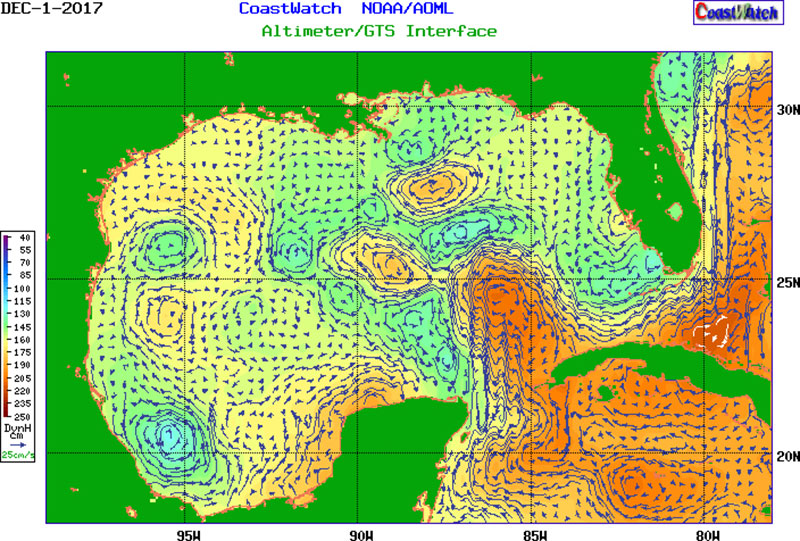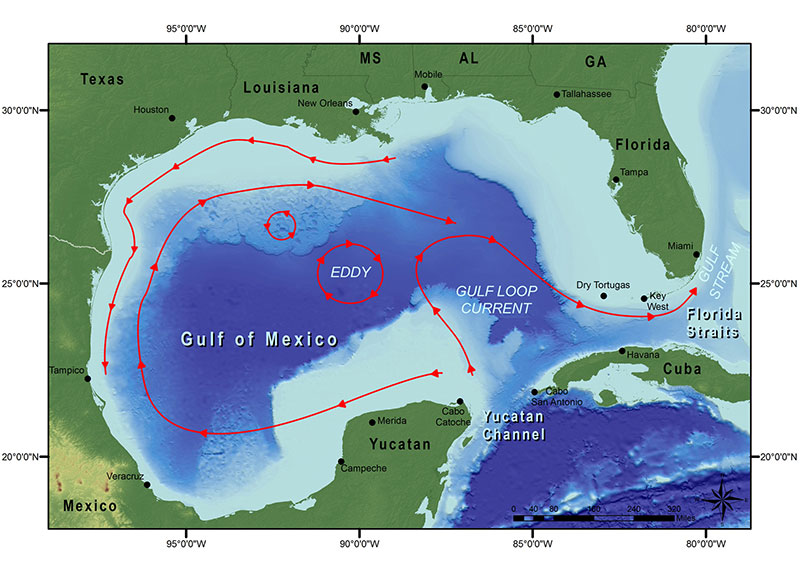
By Robert S. Carney, Professor Emeritus, Department Oceanography and Coastal Sciences, Louisiana State University
December 1, 2017

This map shows the geostrophic currents field in the Gulf of Mexico. Image courtesy of NOAA. Download larger version (jpg, 606 KB).
When conducting science at sea, the challenges are many and scientists must be ready to modify plans, often at the last minute. Sometimes Mother Nature is against us, sometimes we face technical issues or challenges—and sometimes, it’s both.
There are many technical challenges to controlling seafloor exploration from NOAA Ship Okeanos Explorer at the surface as remotely operated vehicles (ROVs) Deep Discoverer and Seirios explore 2,000 meters or deeper on the ocean bottom. Sometimes the challenges of surface and bottom conditions cannot be overcome and a particular location is considered to be undiveable and the team must find a new site to explore. Such was the case for Dive 02, as the Loop Current pushed us east from our originally planned dive site.
The Okeanos Explorer on the surface uses a Dynamic Positioning System that relies on satellite navigation to hold its position and heading within narrow limits, which is made even more difficult as the ship is being pushed by currents, winds, and waves. Deep below the surface, the ROV is probably experiencing weaker currents, but possibly in a different direction than at the surface. And, the entire length of the cable connecting Seirios to the Okeanos is being pushed and pulled according to different currents at depth.
At planned dive sites along the southern portion of the West Florida Escarpment (WFE), the dynamic positioning system cannot always beat all the forces of a unique current system, the Gulf of Mexico Loop Current.
The surface to bottom water of the WFE is a very tiny part of a global circulation system, which is very different at the top of the ocean than at the bottom. Propelled by the uneven solar heating between poles and equator, the atmosphere and ocean are linked systems perpetually in motion. The surface water of ocean basins in the northern and southern hemispheres are driven in great rotating current systems called gyres.

Basic current patterns in the Gulf of Mexico, including the Loop Current. Image courtesy of Flower Garden Banks Marine National Sanctuary. Download larger version (jpg, 1.3 MB).
The WFE is washed by the Loop Current, an unusual part of the western edge of the North Atlantic Gyre. The Loop Current can be especially fast, especially deep, and especially unpredictable. It may flow as fast as 200 centimeters/second (3.89 knots) at the surface and still be flowing at 0.1 meters/sec (0.194 knots) at 1,000 meters. It can elongate and retract along its route from the Caribbean into the Atlantic with an irregular period of 6 to 20 months.
The western edge of all gyres is a region where the rotation of the Earth compresses and speeds up current flow. Although part of the whole gyre, it has been a maritime tradition to name the local segments. The Gulf Loop is the segment of the intensified western boundary current, which flows into the Gulf of Mexico through the Straits of Yucatan and exits through the Straits of Florida. Sometimes the Loop Current’s path is confined to the coast of Cuba. At other times, it flows along a long loop to the north before turning south and eventually exiting through the Straits of Florida. This elongated loop is unstable and pinches off large eddies that spin clockwise as they drift westward. The eddies eventually spin down in the western Gulf.
Because of the north-south extension and retraction, the WFE experiences different flow regimes which can make ROV deployment impossible some time. As the expedition moves west, it will escape the unfavorable impact of the Loop, but before then, we still have a few dives where the Loop Current is going to keep us on our toes.